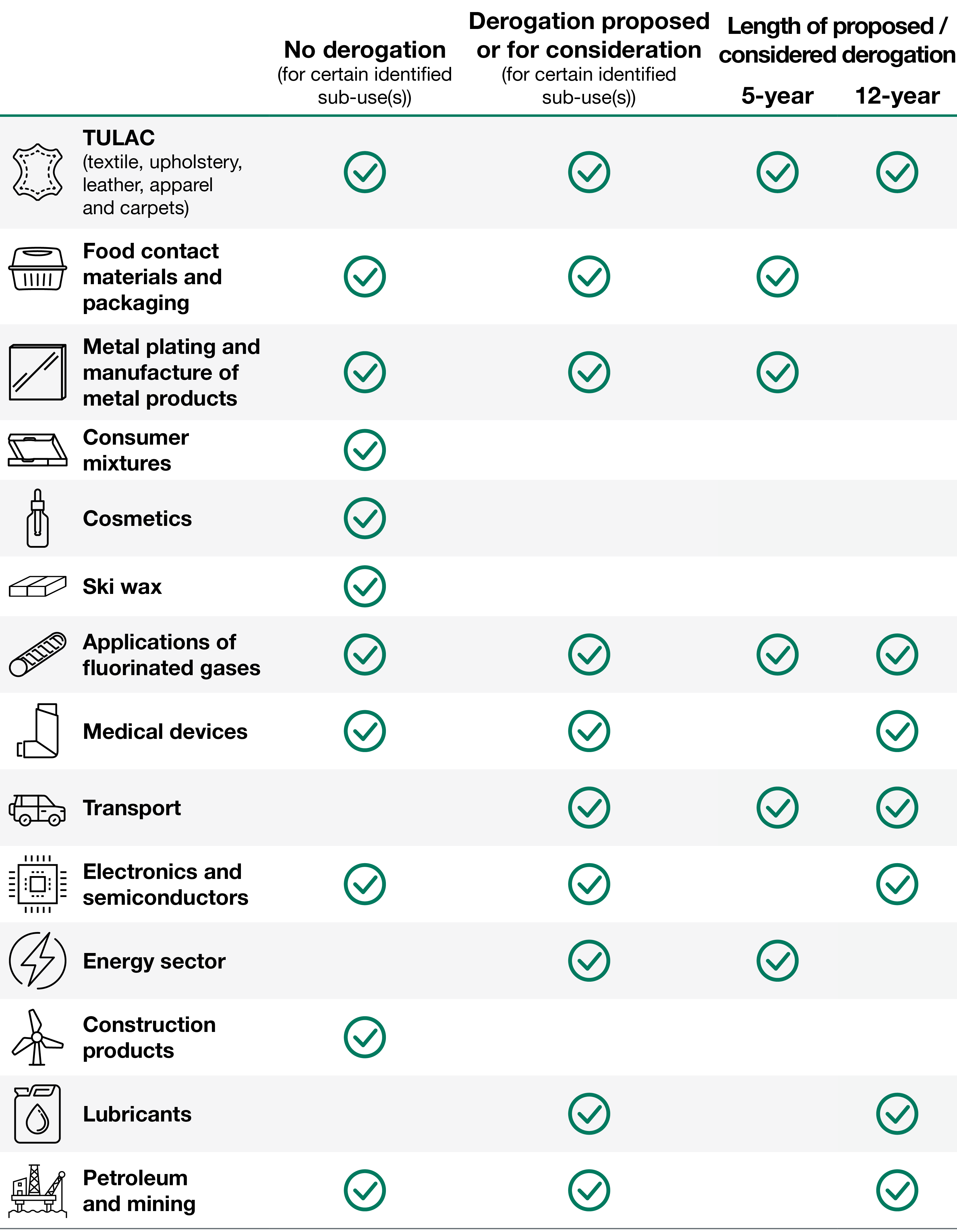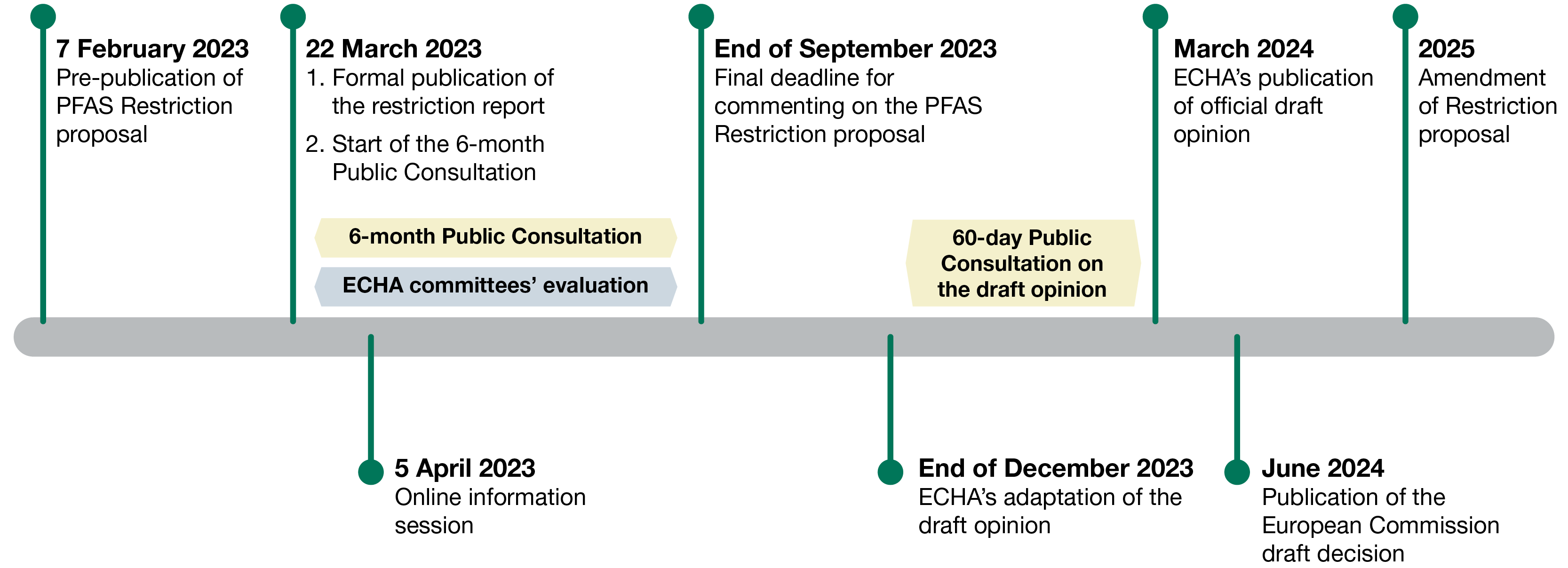In February 2023, the European Chemicals Agency (ECHA) published a proposal to ban per- and polyfluoroalkyl substances (PFAS). As well as affecting EU-based companies directly, companies around the world will see the impact in their supply chains and customer expectations. As is the case with numerous EU chemicals and environmental regulations, there is the possibility that this ban could also serve as a precedent for future regulations in the US and across the globe.
A six-month public consultation on the proposed restriction began on 22 March 2023, giving stakeholders the opportunity to submit information on their uses of PFAS and the availability of fluorine-free alternatives. In this article, we set out what companies need to know about the restriction proposal, how different market sectors are affected and what to do next.
PFAS – the ‘forever chemicals’
PFAS as a class include thousands of synthetic chemicals that are used widely across industries for their properties such as water, oil and dirt repellency; thermal and electrical insulation; and durability under extreme conditions. Well-known uses of PFAS include the manufacture of non-stick cookware, water-repellent clothing, stain resistant fabrics and carpets, some cosmetics and some firefighting foams.
PFAS are often referred to as ‘forever chemicals’. Why? Because their molecules have a chain of linked carbon and fluorine atoms, which is one of the strongest bonds in organic chemistry, making these chemicals extremely resistant to environmental degradation.
The EU’s proposed PFAS ban explained
The production and use of PFAS substances has resulted in severe contamination of soil, water and food and harmful exposure to humans. It is estimated that within the EU, 140,000-310,000 tonnes of PFAS were introduced to the market in 2020. Due to further growth expected within several sectors, in the absence of a restriction, this use volume would be expected to increase.
Because PFAS are persistent in the environment, their release means that ever greater concentrations will build up in the environment, resulting in increasing exposures to humans and other species, including through possible pollution of groundwater and drinking water. PFAS remediation efforts can be complex and require technical expertise. In addition, certain PFAS accumulate in plants, animals and people, causing negative effects in humans if these PFAS have hazardous properties such as reproductive toxicity, carcinogenicity and suspected endocrine disruption.
What’s in the EU PFAS REACH restriction proposal
The Registration, Evaluation, Authorisation and Restriction of Chemicals (REACH) restriction proposal, authored and submitted by five national authorities (the Netherlands, Germany, Sweden, Norway and Denmark), is tailored to address the manufacture, placing on the market (including import), and use of PFAS, including as constituents in other substances, mixtures and articles above a certain concentration in the EU.
The scope of the restriction proposal is very broad (covering more than 10,000 PFAS substances) with two possible restriction options. Restriction Option 1 would result in a full ban after an 18 month transition period whereas Restriction Option 2 (the preferred option of the MS involved in the proposal and the most likely option to be adopted) would result in some instances in a phased ban, with specific time-restricted derogations applying for particular uses. It also includes some time-unlimited derogations for exceptional cases.
Which market sectors are affected and how
In the restriction proposal, the submitting authorities have used literature review, stakeholder consultations and a call for evidence to identify where the largest amounts of PFAS are used and emitted and what the possible alternatives may be. The availability of alternatives seems to be a critical factor in determining whether an immediate ban or time-limited derogation will apply.
Restriction Option 2 considers possible use-specific derogations of five or 12 years, after the 18-month transition from Entry into Force of the REACH restriction. The five-year derogation period will apply where potential alternatives have already been identified but these remain under development and/or are not available in sufficient quantities. Where technically and economically feasible alternatives do not exist or certification or regulatory approval of alternatives cannot be achieved within the shorter derogation period, a 12-year derogation will likely be applied.
The table below shows the fourteen main applications of PFAS that are specifically considered in the proposal (with a non-exhaustive set of sub-uses explored under each application) and the potential derogation types per application:

The sectors and uses where an immediate ban is proposed, due to ‘sufficiently strong evidence of existing technically and economically feasible alternatives’, are detailed below:

Responding to the PFAS Open Public Consultation

A six-month consultation on the restriction proposal, starting on 22 March and ending on 25 September 2023, gives all stakeholders the opportunity to submit information on their PFAS uses and the availability of alternatives. An online information session organised by ECHA, scheduled for 5 April 2023, explained the restriction process to help those interested in participating in the consultation.
In ERM’s experience, companies can benefit by responding early on the scope or timing of the proposed derogations that affect them if they wish to ensure that regulators have time to take their input into consideration. ERM strongly recommends submitting comments, which will require companies to begin developing an assessment report as soon as possible.
Based on the information in the restriction proposal, the comments received during consultation and advice from the Enforcement Forum on the enforceability of the proposed restriction, ECHA’s Risk Assessment Committee (RAC) will form an opinion on whether the proposed restriction is appropriate in reducing the risks to people’s health and the environment. The Socioeconomic Analysis Committee (SEAC) will form an opinion on the socio-economic impacts associated with the proposal.
Once the opinion is adopted, they will be sent to the European Commission who, together with the REACH Committee will then decide on the potential restriction. The draft decision then goes for comment and approval to the EU Parliament and the EU Council. After agreement has been reached on the text, the final decision is published in the Official Journal, and it becomes law. Note that because REACH is a Regulation and the PFAS Restriction is part of that Regulation, the PFAS restriction will immediately apply throughout the EU Member States. The EU’s adoption of the restriction proposal is anticipated in 2025.
How companies can prepare for the PFAS restriction
Companies can take steps outlined below to understand the business implications and prepare for the EU PFAS restriction. These steps will help companies to develop an effective response to the open public consultation and to prepare to replace PFAS with alternatives.

1. Assess product portfolio
Identify and / or confirm the uses of PFAS in product portfolios, as well as in product processes and supply chains.
2. Understand if any derogation types apply
Carry out a comparative assessment of applications and uses of PFAS against the proposed derogations.
3. Define business impact
Develop an impact assessment report on relevant uses to clearly detail (quantitatively where possible) the impact of the restriction proposal to the business, including assessing the availability and impact of PFAS substitutions.
4. Submit impact assessment to the open public consultation
Submit impact assessment reports as a response to the REACH PFAS restriction proposal’s public consultation. Submit before the deadline.
5. Plan PFAS substitutions
Implement proactive efforts to evaluate the ongoing essentiality of PFAS uses by assessing alternatives and both planning and implementing substitution strategies according to a structured plan.
Identifying and replacing PFAS chemicals may appear a nearly impossible task, given their volume and ubiquity. PFAS substitution is not always easy: alternatives must be readily available and offer the right function at the right price without creating new environmental or human health issues.
Methodical analysis of products in the context of company risk management systems can enable businesses to identify and manage their risks accordingly. To avoid supply chain disruption, companies will also need to proactively evaluate PFAS in products throughout the supply chain in the near term to provide adequate lead time for identifying or developing replacements in time for the PFAS ban.
Finally, looking beyond the PFAS REACH Restriction proposal, companies should also consider other aspects of the impacts of all PFAS substances on their operations for example, by identifying PFAS soil and groundwater contamination risks at each site and evaluating associated remediation needs.
An online information session was held on 5 April. During the session, experts from ECHA and the five national authorities explained the restriction process, the content of the proposal and how to participate in the consultation. Find out more

